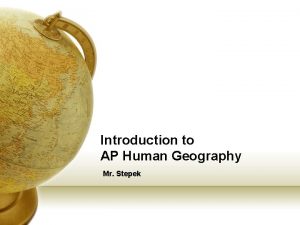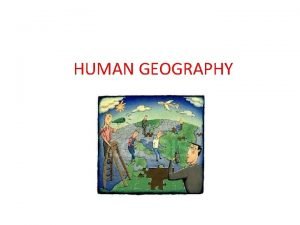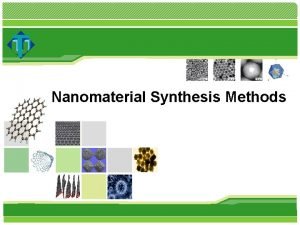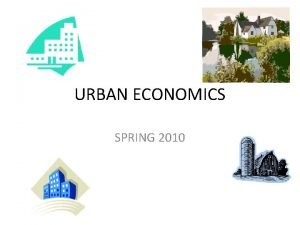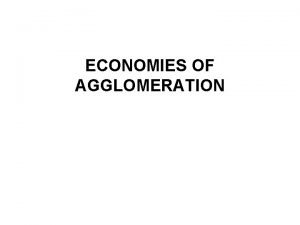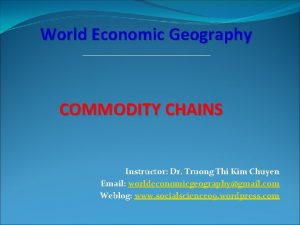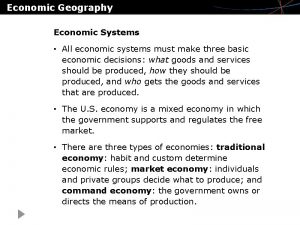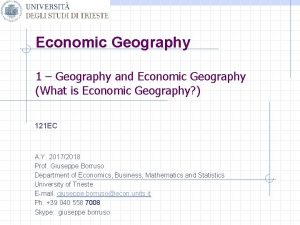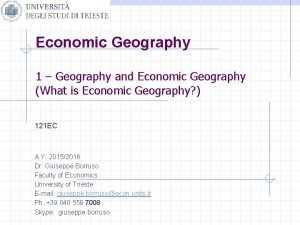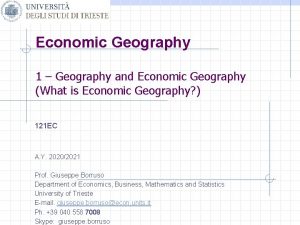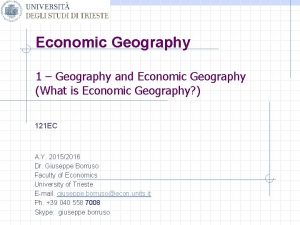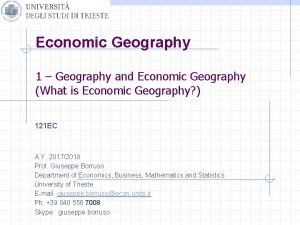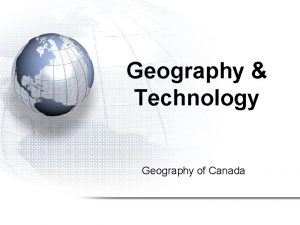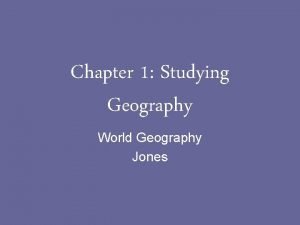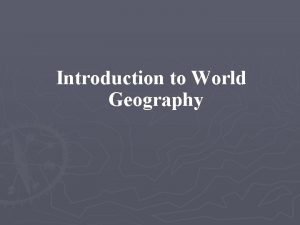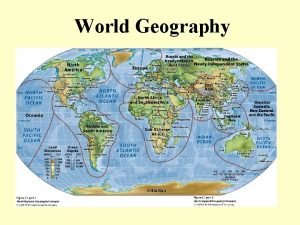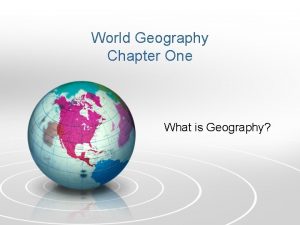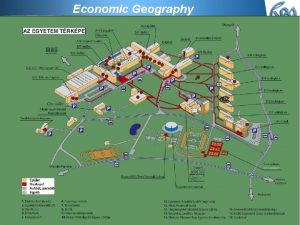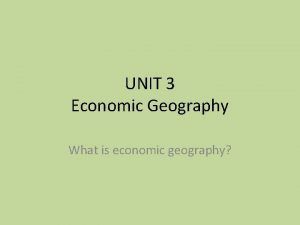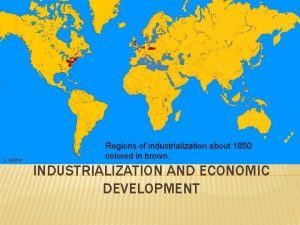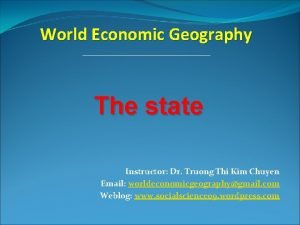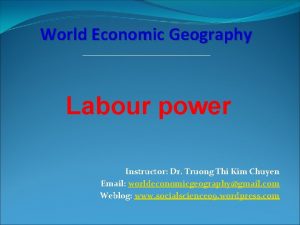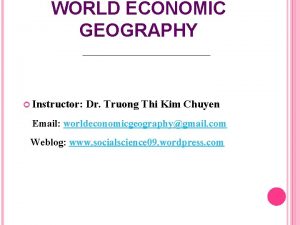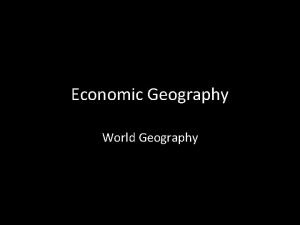World Economic Geography Technology and agglomeration Instructor Dr





























- Slides: 29

World Economic Geography Technology and agglomeration Instructor: Dr. Truong Thi Kim Chuyen Email: worldeconomicgeography@gmail. com Weblog: www. socialscience 09. wordpress. com

World Economic Geography Paul Knox (2008), The geography of the world economy, Routledge; 5 th edition Neil M. Coe, Phillip F Kelly, Henry W. C. Yeung (2007), Economic Geography, Blackwell Publishing Readings: Fellmann – Getis - Getis (1998). Human Geography: Landscapes of Human Activities. Brown & Benchmark.

Course Outline The geography of the world economy Conceptual foundations Dynamics of economic space Actors in economic space Economic Geography 01/ Conceptual foundations Page 1 -25 02/ The changing world economy 04/ Patterns of Development and Change 05/ Services going global 10/ International and supranational institutionalized integration 03/ Commodity chains Page 87 -115 04’/ Technology and agglomeration 06/ The state Page 187 -219 07/ The transnational corporation Page 223 -251 08/ Labour power Page 254 -281 09/ Consumption

AGGLOMERATION: DOES TECHNOLOGY ERADICATE DISTANCE? Aims: To demonstrate how certain kinds of technologies can be used to transcend time and space To appreciate the limits of the spatial impacts of technology on economic systems To understand why proximity still matters of many different kinds of economic activity To reflect on the importance of relational proximity in shaping contemporary economic geographies

OUTLINE Introduction The rise of “Placeless” Production? Understanding technological changes and their geographical impacts Proximity matters: traded and untraded interdependencies within clusters Neither here nor there: thinking relationally Summary

INTRODUCTION The end of geography Relational proximity Node in global networks

THE RISE OF “PLACELESS” PRODUCTION?

UNDERSTANDING TECHNOLOGICAL CHANGES AND THEIR GEOGRAPHICAL IMPACTS Technology must be seen not as a technical process with a life of its own, but rather as a social process through which individuals and organizations deploy technologies to achieve certain ends. Different kinds of technology: Space-shrinking transport and communications technologies Different levels of technological change:

UNDERSTANDING TECHNOLOGICAL CHANGES AND THEIR GEOGRAPHICAL IMPACTS

Technological change needs to be placed in a long-term or evolutionary perspective: The different spatial outcomes of each wave of new technology have interacted with patterns of activity left over form the preceding wave. Space-shrinking technologies: Production process technologies:

- - Space-shrinking technologies: Transportation systems: The advent of commercial jet aircraft, The advent of containerization Communications systems: satellite and optical fibre technology, the Internet, mobile telecommunications, electronic mass media



Call centres Offshoring of services

- - Production process technologies: An appropriate technique of production needs to be selected, and in particular to precise combination of labour and capital The scale of production must be determined. The location of production needs to be decided Over the past three decades, Fordism has been augmented by new modes of production, the chief characteristic of which is production flexibility.

Flexibly specialized production system are skilled craft workers using flexibly machinery to produce small volumes of customized goods






PROXIMITY MATTERS: TRADED AND UNTRADED INTERDEPENDENCIES WITHIN CLUSTERS

PROXIMITY MATTERS: TRADED AND UNTRADED INTERDEPENDENCIES WITHIN CLUSTERS Agglomeration economies: urbanization economies, localization economies Economic bases of agglomeration: traded interdependencies - Vertical disintegration, - Core competencies The social and cultural determinants of agglomeration: untraded interdependencies - Tacit knowledge - Codified knowledge


- Six interacting ways that knowledge is disseminated: Staff turnover Shared suppliers Firm births and deaths Informal collaboration Industry gossip Trackside observation

- A typology of agglomerations Labour-intensive craft production clusters Design-intensive craft production clusters High-technology innovative clusters Flexible production hub-and-spoke clusters Production satellite clusters Bussiness services clusters State-anchored clusters


NEITHER HERE NOR THERE: THINKING RELATIONALLY Global cities Nodes in global networks Institutional proximity Cultural proximity Organizational proximity Relational proximity

SUMMARY Interactions between new technologies and economic geography. Internet is in reality full of spatial inequalities and contradictions of different kinds. Technology can help to at least overcome geographic separation. The ability to move people, money, products, and technologies quickly, efficiently, and cheaply around the world has been highly significant in enabling the globalization of economic activity. The contemporary global economy operates through complex combinations of near and distant relations, and technology plays an important but not determining, role in its operation.
 Us cultural regions
Us cultural regions Agglomeration ap human geography definition
Agglomeration ap human geography definition Rimland theory ap human geography
Rimland theory ap human geography Agglomeration vs aggregation
Agglomeration vs aggregation Agglomération toulouse
Agglomération toulouse Agglomeration economies
Agglomeration economies Agglomeration economies
Agglomeration economies Difference between economic growth and economic development
Difference between economic growth and economic development Human and economic geography
Human and economic geography Economic growth vs economic development
Economic growth vs economic development Economics unit 1 lesson 2 difficult choices
Economics unit 1 lesson 2 difficult choices Ac 61-65
Ac 61-65 Virtual art instructor
Virtual art instructor Exclusive economic zone ap human geography
Exclusive economic zone ap human geography Economic geography
Economic geography Economic geography
Economic geography Types of economic geography
Types of economic geography Frq examples ap human geography
Frq examples ap human geography 5 themes of geography ap human geography
5 themes of geography ap human geography Proruption ap human geography
Proruption ap human geography World history and geography final exam study guide
World history and geography final exam study guide How does wind affect weather and climate
How does wind affect weather and climate Participante pasivo
Participante pasivo Basic instructor course texas
Basic instructor course texas Basic instructor course texas
Basic instructor course texas Basic instructor course tcole
Basic instructor course tcole Pepperball launcher nomenclature
Pepperball launcher nomenclature Subject verb agreement exercise
Subject verb agreement exercise Instructor vs teacher
Instructor vs teacher Ospfv
Ospfv
